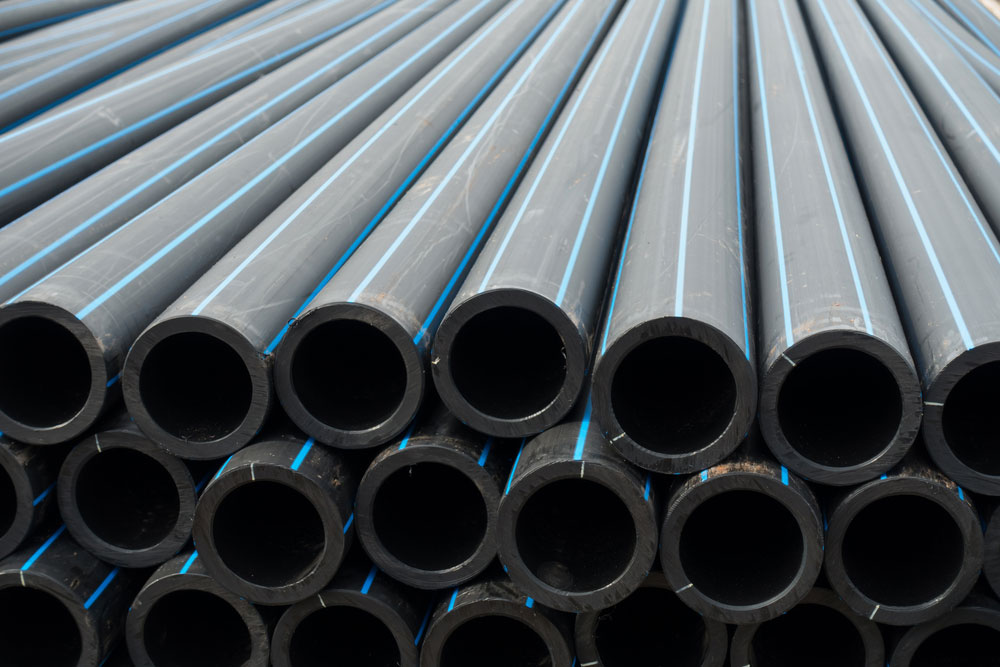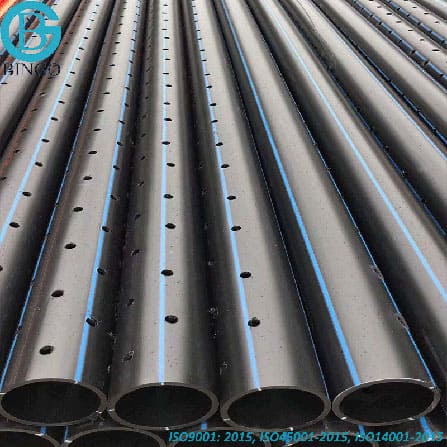Essential Reasons to Choose hdpe pipe suppliers Midland TX for Reliable Sourcing
Wiki Article
Explore the Production Process Behind High-Quality HDPE Pipeline and Its Applications
The production process of top quality HDPE pipes is detailed and methodical. It starts with the choice of resources that enhance efficiency. Following this, ethylene undergoes polymerization to form material, which is after that shaped with extrusion. Quality assurance is vital, ensuring that the final item satisfies rigorous standards. The trip of HDPE pipelines doesn't finish with manufacturing. Their applications throughout various industries expose a more comprehensive importance worth analyzing.Comprehending HDPE: Properties and Advantages

High-density polyethylene (HDPE) is a flexible polycarbonate known for its resilience and resistance to different environmental factors. This material displays exceptional tensile stamina, making it suitable for requiring applications. Its low-density structure contributes to a lightweight product, assisting in ease of managing and installation. HDPE additionally showcases exceptional resistance to chemicals, which lessens degradation when revealed to severe materials.
The material's reduced moisture absorption better enhances its long life, making it perfect for use in pipes and tank. Furthermore, HDPE is resistant to ultraviolet (UV) radiation, making sure that items keep their honesty even when exposed to sunlight. Its flexibility allows for the creation of elaborate shapes without compromising stamina. The eco-friendly nature of HDPE, usually originated from recycled materials, adds to its appeal, advertising lasting practices in manufacturing. Overall, these residential properties and benefits make HDPE a preferred option for numerous industrial and customer applications.
Raw Material Choice for HDPE Production
The choice of resources for HDPE manufacturing is necessary to verify the end product fulfills the desired specs and top quality standards. High-density polyethylene (HDPE) is mostly produced from polymerized ethylene, stemmed from nonrenewable fuel sources such as natural gas or crude oil. The top quality of these feedstocks greatly influences the mechanical and thermal buildings of the last HDPE.Ingredients additionally play a substantial duty in enhancing HDPE's performance, including antioxidants, UV stabilizers, and colorants, which enhance longevity and resistance to environmental factors. The selection process have to think about not only the chemical make-up of the raw materials yet likewise their handling attributes to guarantee reliable manufacturing.
The sourcing of raw products ought to focus on sustainability and compliance with environmental laws, as accountable methods are crucial in today's market. Inevitably, cautious resources option lays the foundation for producing top notch HDPE pipelines appropriate for varied applications.
The Extrusion Process: Forming HDPE Pipeline
The extrusion procedure plays a vital role fit HDPE pipes, starting with thorough material prep work strategies that guarantee suitable circulation and uniformity. Similarly important is the design of the die, which straight influences the last measurements and surface high quality of the pipeline. Together, these aspects add substantially to the efficiency and top quality of HDPE pipeline manufacturing.Product Preparation Techniques
Reliable manufacturing of HDPE pipelines starts with thorough material prep work strategies, specifically the extrusion process. Throughout this phase, high-density polyethylene material is first dried out to get rid of dampness, guaranteeing perfect circulation qualities. The resin is then fed into the extruder, where it undertakes heating and melting, transforming right into a viscous state. This home heating procedure is thoroughly managed to maintain the product's stability and efficiency. The molten HDPE is required with a die, shaping it into a continuous pipe form. Appropriate temperature level management during extrusion is vital, as it directly impacts the material's homes and the last item high quality. As soon as formed, the HDPE pipe is cooled and cut to defined sizes, ready for subsequent handling and applications.Die Design Importance
Precision in die style plays a crucial role in the extrusion procedure of HDPE pipelines. The die functions as the last shaping device, directly affecting the pipe's measurements, wall thickness, and surface area finish. A well-designed die guarantees consistent material circulation, minimizing defects such as irregularities water service line repair and vulnerable points. The geometry of the die must be maximized to fit the particular residential or commercial properties of HDPE, including its viscosity and thermal behavior during extrusion. In addition, the cooling rate of the product as it goes through the die can markedly impact the pipeline's structural integrity. As a result, buying innovative die modern technology is vital for suppliers aiming to generate premium HDPE pipelines that satisfy industry requirements and customer assumptions.Quality Assurance Procedures in HDPE Manufacturing
Although various aspects influence the top quality of HDPE pipeline production, efficient quality control steps are essential to ensure consistency and integrity in the final item. Secret top quality control techniques include extensive material assessment, validating that the raw polyethylene meets well-known standards for purity and thickness. Throughout the extrusion process, parameters such as temperature, stress, and cooling time are very closely kept track of to maintain dimensional precision and architectural honestyAdditionally, post-production screening is vital; producers frequently conduct hydrostatic tests to examine the pipe's toughness and resistance to pressure. Aesthetic examinations for surface area flaws further improve high quality assurance. Accreditation from pertinent requirements companies, like ASTM or ISO, supplies an extra layer of reliability. By carrying out these comprehensive quality control procedures, producers can lessen defects, boost performance, and ensure that the HDPE pipes fulfill the particular requirements of different applications, inevitably leading to consumer complete satisfaction and count on the item.
Applications of HDPE Pipe Throughout Industries
HDPE pipelines are used throughout different fields as a result of their toughness and adaptability. In water distribution systems, they assure reliable delivery, while in wastewater monitoring, they supply trustworthy solutions for waste transportation. Furthermore, agricultural irrigation networks gain from HDPE's resistance to rust and adaptability, making it an ideal selection for contemporary farming practices.
Water Circulation Systems
A considerable number of markets rely upon high-density polyethylene (HDPE) pipelines for reliable water circulation systems. Known for their durability and resistance to corrosion, HDPE pipes are extensively made use of in local water supply networks, farming irrigation, and industrial applications. Their light-weight nature promotes very easy handling and setup, decreasing labor expenses and time. Furthermore, HDPE pipes can accommodate various pressure degrees, making them ideal for both low and high-pressure systems. hdpe pipe fittings Midland TX. The flexibility of the product permits seamless assimilation right into existing facilities, decreasing the requirement for comprehensive excavation. HDPE's resistance to chemical seeping warranties that the water provided remains risk-free and tidy, making it a suitable option for preserving the top quality of potable water throughout various markets.Wastewater Administration Solutions
Reliable water circulation systems likewise lead the way for innovative wastewater administration services, where high-density polyethylene (HDPE) pipelines play a considerable function. Prominent for their resilience and resistance to deterioration, HDPE pipes are excellent for delivering wastewater in different settings. Their adaptability allows for easy setup in complicated environments, reducing the need for considerable excavation. Additionally, HDPE's smooth indoor surface reduces friction, improving circulation prices and effectiveness. These pipelines are likewise resistant to chemical leaching, making sure that pollutants do not jeopardize the surrounding setting. Industries, towns, and therapy centers increasingly rely upon HDPE pipelines for their reliability and durability, making them a preferred option for modern-day wastewater administration systems. This versatility emphasizes the critical value of HDPE pipelines throughout various applications.Agricultural Watering Networks
Agricultural irrigation networks profit substantially from using high-density polyethylene (HDPE) pipelines, which supply effective and reliable water distribution to plants. HDPE pipelines are light-weight, making them simple to transfer and install, while their versatility permits various configurations in diverse surfaces. These pipes demonstrate exceptional resistance to corrosion, chemicals, and UV radiation, making sure longevity in rough farming atmospheres. In addition, their smooth interior surface area lessens rubbing loss, maximizing water circulation and decreasing power prices connected with pumping. The long life of HDPE pipes, typically surpassing half a century, adds to lower upkeep and substitute expenditures. Farmers progressively count on HDPE pipelines to enhance watering performance and advertise sustainable agricultural practices, ultimately leading to enhanced plant returns and source conservation.
Future Trends in HDPE Pipeline Technology
As the demand for lasting and efficient framework grows, improvements in HDPE pipeline technology are positioned to change various markets. Emerging fads consist of the assimilation of wise innovations, such as sensing units and IoT abilities, which help with real-time monitoring of pipeline conditions, reducing maintenance prices and avoiding leaks. Furthermore, the growth of sophisticated manufacturing techniques, such as 3D printing, is making it possible for the production of complex, customized pipe layouts that deal with certain task requirements.The emphasis on recycling and round economic situation techniques is driving the development of HDPE pipes made from recycled materials, enhancing sustainability. Enhanced jointing techniques, such as electro-fusion and mechanical fittings, are also improving installation performance and integrity. The growing emphasis on environmental laws is pressing producers to take on greener production processes, ensuring that HDPE pipes not just satisfy industry criteria however likewise foster a more lasting future for framework growth.
Often Asked Questions
How Does HDPE Compare to Various Other Plastic Products?
HDPE outmatches several other plastic products regarding durability, chemical resistance, and adaptability. Its reduced thickness and high tensile stamina make it suitable for different applications, typically exceeding alternatives in both efficiency and durability.What Are the Environmental Impacts of HDPE Manufacturing?
The environmental impacts of HDPE manufacturing consist of greenhouse gas discharges, energy intake, and prospective pollution from manufacturing processes. In addition, incorrect disposal can cause soil and water contamination, increasing concerns regarding lasting ecological effects.Can HDPE Water Lines Be Reused?
Yes, HDPE pipes can be recycled. Lots of centers approve used HDPE for processing, transforming it into brand-new items. This reusing adds to sustainability efforts, decreasing plastic waste while saving sources and power in the production cycle.What Is the Life-span of HDPE Pipes?

How Do Temperature Level Variations Influence HDPE Pipe Efficiency?
Temperature level variants significantly influence HDPE pipeline efficiency, affecting adaptability and stamina. Heats can cause softening, while low temperature levels might create brittleness, ultimately influencing the pipeline's sturdiness and viability for numerous applications in varied settings.Report this wiki page